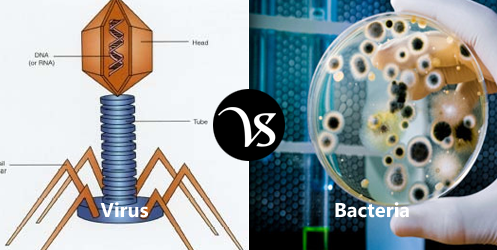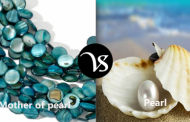 Virus:
Virus:
A virus is a tiny parasite which can infect all types of the life forms from the plants to the animals. There are no free living viruses. Viruses are smaller in size than the bacteria. All the viruses are harmful. Virus cannot live on its own. Viruses are intracellular organisms. It does not have any structures. They cannot be destroyed completely but the process can be slow down by the use of antibiotics.
Bacteria:
Bacteria are very small organisms. Bacteria are so tiny or small that they can be seen only through the use of microscope. Bacteria have different shapes and sizes. Bacteria constitute a large domain of prokaryotic microorganisms. They are the unicellular organisms with a cell wall. Bacteria are found everywhere. Some bacteria are useful as well as harmful. There are at least 5 nonillion bacteria in the Earth.
Differences:
| Basis | Virus | Bacteria |
|---|---|---|
| Definition | An infective agent that typically consists of a nucleic acid molecule in a protein coat, is too small to be seen by light microscopy, and is able to multiply only within the living cells of a host (www.oxforddictionaries.com) |
a very large group of microorganisms comprising one of the three domains of living organisms. They are prokaryotic, unicellular, and either free-living in soil or water or parasites of plants or animals. (www.thefreedictionary.com) |
| Synonyms | Germ, disease, microbe, sickness and microorganism | Organisms, microbes, bacilli, pathogens |
| Antonyms | Health and good health | Antidote |
| Types | Its types are:
|
Its types are:
|
| History | The scientific study of viruses and the infections they cause began in the closing years of the 19th century. By the 20th century many viruses were discovered. | Anton van Leeuwenhoek, the Dutchman, was the first person to see bacteria. He first observed bacteria through his single-lens microscope in 1674. |
| Word origin | It was originated from Late Middle English (denoting the venom of a snake): from Latin literally ‘slimy liquid, poison’. | It was originated in 1905-10; < New Latin < Greek baktḗria, plural of baktḗrion |
| Ribosomes | It is absent. | It is present. |
| Size | It is smaller. | It is larger. |
| Number of cells | It is unicellular. It has one cell. | It does not have cells. It is not living. |
| Cell membrane | There is no cell membrane. | It is present below the cell wall. |
| Pronunciation |
|
băk-tîr′ē-ə |
| Genetic material | It can be DNA or RNA. | The genetic material is DNA. |
| Host | It can grow on the non-living surfaces as well. | It needs a living host such as plant or an animal. |
| Antibiotics | The use of antibiotics cannot kill viruses but slow down the process of bacteria. | The use of antibiotics can kill bacteria. |
| Living | It is both the living and non-living things. | It is living thing. |
| Advantages/Benefits | Its advantages are:
|
Its advantages are:
|
| Disadvantages | Its disadvantages are:
|
Its disadvantages are:
|
| Example in Sentence |
|
|





